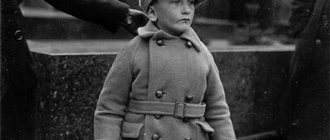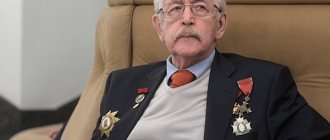Childhood and youth
Lilya Brik was born on November 11, 1891. Her father, Uri Kagan, was a lawyer who actively fought for the rights of Jews. In addition, he was very fond of literature and even named his own daughter in honor of I. Goethe’s wife. My mother was fond of art - she played the piano, wrote poetry, and often organized musical evenings.
Her parents took care of her daughter’s good education, so from childhood Lilya knew a lot about ballet, played the piano and spoke foreign languages. In addition, she always knew how to start and maintain a conversation on secular topics. She was allowed to try and find herself. She studied at the Higher Women's Courses, at the Moscow University of Architecture and even managed to practice sculpture in the Munich studio of Schwegrel.
Vasily Katanyan - Lilya Brik. Life
1 …
Vasily Katanyan
LILYA BRIC. LIFE
Introduction
I first saw Lilya Brik and Vladimir Mayakovsky a long time ago, in the late twenties. Our family lived nearby in a dacha in Pushkin near Moscow, and we sat on their terrace; the adults laughed a lot.
I liked my visit and liked this short woman, cheerful and affectionate towards me. I vaguely remember that I was struck by her hair of an unusual color that I had never seen before. I grew up among black-headed Caucasians, but the Moscow kids in the yard were blond, and Lily’s hair was an incomprehensible color and even, as it seemed to me, sparkled gold.
On the way home I asked what it was?
She is red, which is an unusual color and rare. And she herself is rare, unusual,” my mother added.
I was convinced of this by communicating with her for half a century - first as a boy, then as an adult, not to say an elderly person - after all, I was born in 1924. And in 1978, when, by the will of fate, I became the executor of Lily Yuryevna, the life of this woman was prolonged in my mind by her diaries, epistolary, memoirs, as well as memoirs about Mayakovsky and about her with slander and nonsense, with printed lies and secret denunciations. And at the same time, her archive, overriding the fictions, revealed to me the enthusiastic pages about her by outstanding people of the 20th century - both prose and poetry.
Most of her life passed before my eyes. I have the opportunity to use her archive - so I will tell about her to those who are interested in her and her “romance with Mayakovsky”, I will describe much of what I witnessed.
Fully sharing the point of view of Anna Akhmatova, I also do not believe the memoirs written sequentially, year after year. After all, memory, like a spotlight, highlights events flying ten years into the future or, conversely, depicting retrospection. Therefore, it is not surprising that after 1926 the heroes end up in the 72nd, and return to the 38th.
And if you want to read this book, then you will find here my personal memories, and archival documents, and stories of people who knew her affair with the great poet, who, having dedicated his work to her, called her “the author of my poems,” and in life called Lichik, Luchik, Lilyatik, Kisa and simply Lilichka. She also did not skimp on affectionate names for Vladimir Vladimirovich, which can be read in her letters and notes to him.
Part I Mayakovsky's Love Boat Two sisters and two boys
Once we watched a film on television where some company was riding in a cab. In response to my remark, Lilya Yuryevna exclaimed:
God, have you never seen a live cab driver? To me, they seem more familiar than taxis with their checkers. And they took us to the gymnasium on a horse-drawn horse. Trams had only just begun to appear, and asphalt was still a novelty; there were cobblestone streets or end streets everywhere. Yes, and the noise of the street was completely different, but not only from this, but also from the screams of peddlers and hawkers, the screams of ragpickers, not to mention the continuous ringing of bells, under which my childhood passed. I remember this well, as well as the Christmas holidays, Easter holidays, and disputes about the Artistic Public, in which we heard the name of Stanislavsky. On holidays, my sister and I were taken to the cinema, where our hearts sank with delight, although the lady sitting in front always wore a huge hat, covering the floor of the screen... And I remember how we were very afraid of the Turks with crooked sabers that covered the monument to the heroes Plevna at the Ilyinsky Gate, not far from our house...
So somehow we unnoticed a conversation about childhood with Lilya Yuryevna, who was born in 1891 in the center of Moscow, not far from the Turks with crooked sabers.
Her father Uri (Yuri) Kagan was a sworn attorney, worked as a legal adviser at the Austrian embassy, and also dealt with the “Jewish question” - problems related to the right of residence of Jews in Moscow. The girl remembered eccentrically dressed Austrian actresses who came to her father on various matters. Mother, Elena Yulievna, was from Riga and graduated from the Moscow Conservatory in piano. The father was fond of Goethe and named his daughter in honor of the beloved of the great German poet Lily Schenemann. And five years later, sister Elsa was born. The children received an excellent upbringing, their parents gave them a good education, and from childhood the sisters spoke French, German, and played the piano. Both were charming.
“One day in early spring, I was walking with my daughters along Tverskoy Boulevard,” Elena Yulievna recalled. “And a gentleman in a luxurious fur coat was driving towards us.” He stopped the cab driver and exclaimed: “God, what lovely creatures! I would like to see you with them at my performance. Come to the Bolshoi Theater tomorrow and say that Chaliapin invited you.” We took advantage of the invitation, and seats were reserved for us in the box. It was such an amazing meeting.”
The girls attracted attention. Lily had huge eyes and bright red hair. She was spirited, independent, and her parents adored her. She excelled at the gymnasium, especially in mathematics, and immediately did not want to be “like everyone else.” She grabbed scissors and cut off her braids - to the horror of her parents. (And in old age it was the other way around: at the age of eighty-five she braided her hair - to the delight of her admirers.) Probably, this was still an unconscious refusal to blend in with the crowd, a subconscious rejection of the stereotype. Elsa was a beautiful, blond, blue-eyed girl, very obedient and meek. Both studied at the gymnasium on Pokrovka. The sisters loved each other all their lives, but the eldest ruled since childhood.
When the girls were still little, their mother took Lilya and Elsa to the theater. The sisters were greatly impressed by the sorceress, who raised her wand and said “Krux!” and turned the children either into a cat or into a Christmas tree. Eight-year-old Lila especially liked this trick.
Elsa, bring me an apple from the dining room.
Go yourself.
What?!
Lilya took the curl that had fallen off the sideboard, picked it up like a sorceress, and Elsa understood that “Krux!” would sound, that she would turn into a kitten, and ran headlong for the apple.
Elsa, close the curtain.
Don't want.
Do not want?!
Lilya grabbed the curl, and Elsa rushed to draw the curtain.
Mom put an end to this slavery. Seeing Elsa constantly frightened, she asked her what was the matter, and I had a blast.
In the bedroom, their beds stood next to each other, and as soon as the lights were turned off, the girls began to whisper - to play, to write a novel or play. The characters were divided in half, Elsa spoke for one half, Lilya for the other. There were princesses, countesses, princes and barons with beautiful surnames. Moreover, the Sokolovs, Orlovs, Sinitsyns seemed beautiful to them - from the words “falcon”, “eagle”, etc. The situation was never repeated, the heroes studied, got sick, got married, everyone was engaged in art. There were not enough diverse arts for everyone, and one princess had to do amazing embroidery directly from life. The girls quarreled because Lilya took the most spectacular surnames and the most beautiful art. The game sounded like this: “Then Princess Obolenskaya put on a dress made of pale apricot moire, all embroidered from life with autumn leaves, she pinned a wreath of tea roses on her head and went to the concert at which the singer Tamara Valentinovna Orlova was supposed to sing. Now tell me what happened next.”
1 …
End of introductory passage
You can buy the book and
Read more
Want to know the price? YES I WANT TO
Romance novels
One of the brightest episodes in Brick’s biography is her love affairs. In her youth, she had a truly magical influence on men, most of whom fell under the charms of the charming woman at their first meeting. F. Chaliapin, G. Rasputin, V. Mayakovsky and many others could not resist her. Among the actress’s many admirers there was even an uncle, in response to whose active courtship the girl was sent to Katowice. She told many of her fans: “The best way to meet people is in bed.” One of the rare exceptions was her legal husband O. Brik, whom Lilya herself sought.
Union with Mayakovsky
The poet's first acquaintance with the Brik family was not with Lilya. Even before meeting her, he was in a relationship with her younger sister Elsa Triope, who later became a famous poetess. Their romance lasted two years and could have lasted even longer if not for that fateful meeting. In July 1915, Elsa decided to introduce Mayakovsky to her parents and invited her to her house, where Lilia was also. Seeing a beautiful stranger, the poet fell in love at first sight and even read her the as yet unpublished poem “A Cloud in Pants.” Despite this turn of events, Elsa will maintain good relations with Vladimir until the end of his days.
The romance between Brik and Mayakovsky developed rapidly. Having found himself in a love net, the poet courted violently and passionately. He was delighted with the well-mannered and well-read girl, who, in his opinion, surpassed even Burliuk himself in this regard. Just at this time, she had a crisis in her relationship with her husband, about whom Lilya would later say: “Our personal life somehow spread apart.” Soon their meetings began to take place every day, and they became almost inseparable. Mayakovsky even moved to Nadezhdinskaya Street to be closer to his beloved. Unlike the expressive poet, Brick always knew how to keep her distance without succumbing to crazy emotions. She called him “you” for a long time and forbade him to talk about dating.
Soon Mayakovsky will become part of the Brikov family, and the three of them will live together. There have always been many questions about everyone's role in this love triangle. Lilia herself tried to answer them, characterizing Osip as the person she loved “more than a brother, husband and son.” It is obvious that over time he found himself in a strange role with a very independent and characterful wife. Most likely, in this example we can observe the relationship between three not very happy people. Osip Brik did not love his wife, and she did not experience mutual passion for Mayakovsky.
Brik never wanted to have children - neither from Osip nor from Mayakovsky. She later said that she did not want to subject her child to the torment that she herself experienced. But she always treated other people’s children with special trepidation.
It is interesting that even during this period of strange family life, Brick managed to start relationships on the side. For example, in 1922 she became interested in A. Krasnoshchekov, who worked in several Soviet government agencies.
Mayakovsky
In 1913, the poet met Elsa, Lily’s younger sister. The girl came to visit old friends and there she saw an unusually tall and awkward poet in a black velvet blouse. He didn't attract attention until he started reading The Riot of Things. The guests switched their attention to this strange guy, and in the evening Mayakovsky already went to accompany Elsa home. The girl was only 17 years old at that time. They started dating and he met her parents. At this time, Lilya and her husband were constantly traveling. For two years the poet courted Elsa. This fact was of great interest to everyone who studied the biography of Mayakovsky. For such a long time, he did not write a single line about his girlfriend. Although he was famous for the fact that he loved to dedicate poems and poems to loved ones or simply to people he liked.
The poet's muse
In the dedication to the poem “Cloud in Pants,” Mayakovsky will write a short but meaningful: “To you, Lilya.” In his collected works he is about - “L.Y.B.” With the same three-letter designation, the poet will give his beloved a memorable ring. In 1928, he dedicated to her all his works written before the moment they met.
In 1916, the poem “Flute-Spine” and the poem “Lilichka” were published, imbued with the deepest feeling of love for Brik. Two years later, she and the poet would star in the film “Chained by Film,” but the film was burned, and only a few photographs and a large poster remained as a souvenir. In 1922, the poet completed the poem “I Love,” in which he expressed all the feelings for his beloved that tormented him at that time.
After Mayakovsky's death, Brik managed to ensure that he continued to be published. According to rumors, she managed to contact Stalin himself and convinced him that such a poet should not be forgotten. The General Secretary heeded the woman’s requests and demanded to “restore what was lost,” thereby facilitating the creation of the Mayakovsky Museum.
Lilya Brik and the security officers: how Mayakovsky’s beloved worked for the special services
In 1926, an unusual family of three - Mayakovsky, Lilya and Osip Brik - settled in Gendrikov Lane, now Mayakovsky Lane. Here in house 15/13 Lilya Brik soon created her own salon. They went there not for the sake of the hostess, but to look at Mayakovsky and other famous guests. Mayakovsky's apartment - Brik was constantly visited by famous writers: Velimir Khlebnikov, David Burliuk, Vasily Kamensky, Nikolai Aseev, Sergei Yesenin, Vsevolod Meyerhold, Maxim Gorky, Boris Pasternak. At evenings in the salon there were conversations about literature, and they also enjoyed card games: they played vint, poker, “aunt” and “piece of iron”.
But the salon existed not only thanks to the popularity and charm of its owner, but with the support of the deputy head of the secret department of the OGPU, Yakov Agranov, the executioner of the NKVD, on whose conscience were dozens of executed people, including the poet Nikolai Gumilyov. Agranov's specialty was supervision of the intelligentsia. It was he who compiled the lists of writers, philosophers and scientists who were expelled from the USSR on the “philosophical ship” in the fall of 1921. In addition to Lily Brik's salon, Agranov successfully infiltrated Moscow literary circles: he communicated with the writer Boris Pilnyak and RAPP leader Leopold Averbakh, and was a member of the artistic council of the Meyerhold Theater. With such “support”, the purpose of the existence of Lily Brik’s salon was rather prosaic - control over the creative intelligentsia.
An interesting fact is that everyone knew where Agranov worked, and at the same time this information did not bother anyone. They willingly accepted him, communicated with him and, moreover, valued communication with him. They addressed him in the salon quite simply and even sweetly: Yanechka or Agranych. But Yanechka Agranov was not the only security officer in Lily’s circle. Valery Gorozhanin, head of the special bureau under the NKVD, was also a frequent guest. Mayakovsky dedicated one of his poems, “Soldiers of Dzerzhinsky,” to the town dweller. They worked together on the script for the film "Engineer D'Arcy", and he introduced the poet to many security officers who began to visit him. The deputy head of the foreign department of the GPU, Mikhail Gorb, often visited the salon.
We stand with the enemy cheekbone, and death stands, awaiting the harvest. The GPU is the clenched fist of our dictatorship. Protect the paths and rivers, blood and shelter, take the enemy, secrets, and cut the KRO!
Vladimir Mayakovsky, “Soldiers of Dzerzhinsky”
These people watched the owners of the salon and their guests, were aware of their affairs and conversations, and conveyed information about the mood of the intelligentsia who were in the house.
But not all writers were happy with Lily Brik's salon. Anna Akhmatova had a very negative attitude towards this circle. Lydia Chukovskaya in “Notes about Anna Akhmatova” quotes the poetess: “Literature was abolished, only the Brikov salon was left, where writers met with security officers.” The poet Boris Pasternak also spoke unflatteringly about his friends’ salon: “The Brikov apartment was, in essence, a Moscow police station.”
But the friendly attitude of the salon owners towards law enforcement officers is easily explained. Mayakovsky could leave the country and go wherever he wanted precisely because he enjoyed the protection of the OGPU. For people from his literary association LEF, sympathy for security agents was not something shameful. Quite the contrary, they considered the security officers to be heroes in the common struggle for the victory of communism.
During the years of perestroika, publicist Valentin Skoryatin had the opportunity to study previously closed archives and found information in the NKVD repositories that Lilya Brik was an agent of the secret service and had certificate No. 15073. Lilya Yuryevna’s husband, Osip Brik, also did not stand aside, he was a secret agent department from June 1920 to January 1924. His duties included monitoring the former bourgeoisie. This appointment was the reason for the appearance of a piece of paper attached to the front door of a family in Poluektov Lane with a quatrain, whose authorship is attributed to Sergei Yesenin: “Do you think Brik, / a language researcher, lives here? / A spy lives here / and a Cheka investigator.” Osip often returned from work after midnight, and Lilya often said to her guests: “Wait, we’ll have dinner as soon as Osya comes from the Cheka.” But his “career” in the authorities turned out to be much shorter than that of his wife: Osip Brik was dismissed as a deserter for evading participation in security operations.
All these people really were Lili’s friends, if only because they did not disappear from her salon even after Mayakovsky’s death. And when Yakov Agranov was shot in 1938, the salon did not cease to exist. Moreover, since 1935, by personal order of Stalin, it was the Briks who became the official heirs of the memory of Mayakovsky, organizing a museum in Gendrikovsky Lane. But Mayakovsky’s sister Lyudmila really wanted to create her own new museum in honor of her brother to replace the Brik one, and in general she believed that Lilya and Osip were profiting from the memory and legacy of her brother, so she complained to the CPSU, although to no avail.
Briks are an antisocial phenomenon in public life and everyday life and can only serve as a destructive example and contribute to anti-Soviet propaganda in a broad sense abroad
Lyudmila Mayakovskaya, letter to the CPSU Central Committee
Apparently, Lila enjoyed her role as an agent. She also tried to attract her acquaintances to cooperate with the authorities. Soviet writer and translator Rita Wright admitted that Lilya once tried to recruit her as an informant in Russian emigrant circles in Berlin. She agreed, but after the first interrogation the agents decided not to work with her: the information Wright provided did not contain any important information.
Still, thanks to Lilya Brik, the KGB had access to the leadership of the French Communist Party, Louis Aragon (her sister Elsa’s husband) and Jacques Duclos. Therefore, Lilya had privileges in the USSR, especially when it came to traveling abroad. So, in the 1960s, Brik helped Maya Plisetskaya, who was restricted from traveling abroad, to go on tour with the Bolshoi Theater troupe to America. Lilya herself could leave the country at any time without any obstacles. This means that the ID of an employee - an agent of the GPU - that was once issued to her was valid.
Creative activity
After Mayakovsky appeared in Brik’s life, she met many representatives of cultural bohemia - M. Gorky, B. Pasternak, V. Khlebnikov, D. Burliuk and many others.
In the late 20s, Liliya Yuryevna turned to cinema - she worked as an assistant during the filming of the film “The Jew and the Land” and became a co-author of the script for the film “The Glass Eye”. She also took up translations of German authors and Mayakovsky's publishing affairs. Brik is the author of several literary theoretical works, for example, on the work of F. Dostoevsky. His passion for sculpture resulted in the creation of amateur works dedicated to V. Mayakovsky, O. Brik, V. Katanyan.
In the 60s, her apartment on Kutuzovsky was well known as the center of cultural life, an alternative to the official ideology. Among her acquaintances were stars of the first magnitude - M. Plisetskaya, R. Shchedrin, L. Utesov, F. Ranevskaya, R. Zelenaya, L. Orlova, A. Mironov and many others.
Trips
In 1922, the girl left for Berlin. She needed rest, as she was exhausted by the constant meetings of futurists in their apartment. Osip and Mayakovsky joined her in the fall. A period of relaxation began - they visited expensive restaurants and lived in a luxury hotel. After the harsh Russian reality, abroad seemed to the poet a wonderful dream. He did not skimp on gifts for his beloved - fresh bouquets were delivered to her every day. The family goes to poetry and literary readings. For the poet, the big city was like a new toy for a child - he admired and could not help but be touched by its liveliness.
The next time they went to Germany by plane. Mayakovsky was not allowed to take the manuscripts with him - the gendarmes confiscated them right at the airport. The flight did not frighten the poet - he received a lot of new impressions. Then there was a trip to the resort in Norderney. Once again, a period of discovery has come for Mayakovsky - the sea. According to Shklovsky's memoirs, the poet played with the sea like a boy. In 1928, Vladimir Vladimirovich traveled alone to Paris. He has an important assignment from Lily - to buy her a Renault car. She described exactly what kind of car she needed, and the poet delivered the purchase to Moscow, despite the fact that at that time he had difficulties with money. Lilia became the second woman in Moscow to drive herself.
Personal life
Lilia Brik's huge number of hobbies grew into three official marriages. In addition to Osip Brik, she married Vitaly Primakov, who was the commander of the Chervonnye Cossacks during the Civil War and was shot along with other military leaders in 1937. Brik's last husband was Vasily Katanyan, literary critic, writer, publisher of works and biographer of V. Mayakovsky. True, Lilia herself added a great poet to them. One day she will say: “I have always loved one - one Osya, one Volodya, one Vitaly and one Vasya.”
In 1978, Liliya Brik received a serious injury for her age - a fracture of the femoral neck, which confined her to bed. In order not to be a burden to her husband, she took a large dose of sleeping pills, which became fatal. A few days before her death, Brik wrote in her diary that Mayakovsky appeared to her in a dream, whom she scolded for suicide, and in response he handed over a pistol with the words: “You will do the same.” She died on August 4, 1978. After her death, Liliya Yuryevna was cremated, and her ashes were scattered near Zvenigorod.
Death
At the age of 86, Lilia broke her hip and, in order not to suffer herself and not be a burden to those around her, she committed suicide by taking a lethal dose of sleeping pills. This happened on August 4, 1978.
Brik’s ashes were scattered near Zvenigorod (the village of Busharino, Odintsovo district, Moscow region), and at the site of the farewell ceremony a gravestone with the inscription “L. Yu. B." (Lilia Yuryevna Brik). Mayakovsky engraved these same three letters on the ring, which the avant-garde muse did not part with for a second.
Lilya Brik in old age
It is worth noting that two years before the tragedy, Brick had already tried to commit suicide. True, then her attempt to die was more like a rehearsed performance. The ambulance, which arrived at the performance on the day of the premiere, found a farewell note on the table in which Lilya asked not to blame anyone for her death. After the heart-warming speeches there was a signature and the name of the drug that she took to leave this mortal coil. That day, doctors literally pulled Brik out of the dead, washing her stomach and putting her on bed rest.









